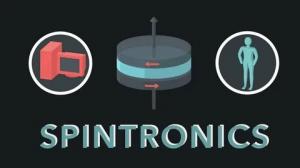Spintronics Market to Hit USD 98.65 Billion by 2035, Fueled by MRAM Adoption and Spin-Based Logic Circuit Demand
The spintronics market is projected to reach USD 98.65 billion by 2035, driven by MRAM use and advances in spin-based computing.
The demand for higher memory density, lower power consumption, and faster read/write speeds in modern computing systems has created strong momentum for MRAM, a key application of spintronics. MRAM is increasingly being adopted by major data center operators, chip manufacturers, and electronics companies as it offers durability, data retention without power, and rapid access times. In addition, the integration of spintronics in advanced sensors is gaining attention, particularly in the automotive and aerospace sectors, where accuracy, durability, and low-power operation are critical. Research institutions and semiconductor manufacturers are heavily investing in R&D to unlock the full potential of spin-based quantum computing, where spintronics offers promising pathways toward scalable and stable qubits. As digital transformation accelerates globally, spintronics is set to play a pivotal role in enabling next-generation computing and memory technologies.
Propel Your Success: Secure Your Sample of Our Insightful Report Now!
https://www.futuremarketinsights.com/reports/sample/rep-gb-5912
Key Takeaways from the Spintronics Market:
The global spintronics market is forecasted to surge from USD 13.1 billion in 2025 to USD 98.65 billion in 2035, driven by a CAGR of 15.8%, reflecting strong industry interest in spin-based technologies. Magnetoresistive RAM (MRAM) is a major growth driver due to its superior speed, endurance, and non-volatility compared to conventional memory technologies. Spin-transfer torque (STT) devices and spin-based logic circuits are also gaining commercial interest as the need for low-power, high-efficiency computational solutions increases. The Asia Pacific region dominates the market in terms of manufacturing capacity and demand, owing to the presence of semiconductor giants in China, South Korea, and Japan. North America and Europe are also strong contributors, propelled by R&D in quantum technologies and spin-based applications in defense, aerospace, and automotive sectors. Consumer electronics, automotive, industrial automation, and IT infrastructure are key end-use industries adopting spintronics for high-speed, energy-efficient memory and sensing applications.
Emerging Trends in the Global Spintronics Market:
The market is witnessing a surge in research and commercialization efforts focused on next-generation memory solutions, particularly STT-MRAM and SOT-MRAM (spin-orbit torque). These memory types offer faster switching speeds, lower power usage, and longer write endurance, making them highly suitable for enterprise storage and mobile device applications. Quantum spintronics, a fusion of quantum information and spin-based physics, is emerging as a transformative trend, enabling innovations in quantum computing and secure communication systems. Additionally, spintronic-based biosensors are being explored for ultra-sensitive medical diagnostics, leveraging magnetic field detection for biomolecule analysis.
Another trend shaping the industry is the development of hybrid spintronic devices that integrate with CMOS (complementary metal-oxide-semiconductor) technology to enhance compatibility with existing chip architectures. This co-integration is essential for mass adoption in consumer electronics and embedded systems. Moreover, the automotive industry is embracing spintronic sensors for applications like advanced driver-assistance systems (ADAS), vehicle navigation, and electric motor control due to their precision and reliability under extreme conditions. The global shift toward energy-efficient and faster processing hardware continues to push spintronics to the forefront of semiconductor innovation.
Significant Developments in the Global Sector: Trends and Opportunities in the Market:
Several significant advancements are reshaping the spintronics industry. Semiconductor firms and research organizations are actively working on reducing the size and improving the efficiency of spintronic components, aiming to meet the demands of ultra-scaled, high-performance electronics. Governments and private investors are pouring funding into spintronics research, particularly in the U.S., EU, and East Asia, recognizing the potential of spin-based technology to extend Moore’s Law and support digital sovereignty.
One of the most promising areas of development is in non-volatile logic circuits that combine memory and logic functions, potentially revolutionizing the way computation is carried out by reducing latency and energy use. Additionally, opportunities are emerging in developing countries where investment in advanced manufacturing and semiconductor infrastructure is on the rise. Partnerships between academia and industry are also catalyzing breakthroughs in spin-caloritronics, spin Hall effect, and spin Seebeck effect, opening new frontiers in energy harvesting and thermal management technologies.
Recent Developments in the Market:
The spintronics market has seen a flurry of recent innovations and collaborations. Leading memory manufacturers have begun commercial production of STT-MRAM chips, offering improved performance over NAND and DRAM in several applications. In parallel, startups and academic institutions have announced prototypes of spintronic processors and quantum spintronic devices that demonstrate practical pathways for commercial implementation. Companies such as Samsung and TSMC are integrating MRAM into microcontrollers and mobile processors to improve device responsiveness and power efficiency.
Several international conferences and consortia have also been established to facilitate knowledge exchange and standardization in spintronics. In the automotive sector, partnerships between OEMs and semiconductor suppliers are underway to co-develop robust spintronic sensors for future mobility platforms. Furthermore, defense agencies are exploring spin-based memory for radiation-hardened electronics used in satellites and strategic systems, where data integrity is mission-critical.
Comprehensive Industry Report: A Full Market Analysis
https://www.futuremarketinsights.com/reports/spintronics-market
Competition Outlook:
The spintronics market is moderately consolidated, with a mix of established semiconductor players and emerging technology developers. Competition is based on technological differentiation, patent portfolios, fabrication capabilities, and strategic alliances. Leading firms are investing heavily in R&D and are forming cross-industry collaborations to accelerate time-to-market for next-generation spintronic solutions.
Key Players
Key players in the global spintronics market include Intel Corporation, Samsung Electronics Co., Ltd., Everspin Technologies Inc., NVE Corporation, TDK Corporation, Crocus Technology, IBM Corporation, Toshiba Corporation, Qualcomm Technologies Inc., and Spin Memory Inc. These companies are at the forefront of spintronic device innovation, spanning MRAM production, sensor technology, and quantum research.
Key segmentations
The market is segmented by device type, including MRAM, spin-transfer torque devices, spin valves, and spin-FETs; by application, covering data storage, magnetic sensors, quantum computing, and others; and by end-use industry, such as consumer electronics, automotive, industrial, healthcare, and IT. Among these, MRAM is expected to remain the dominant segment, driven by its fast adoption in consumer devices and data centers. Spintronic sensors are also projected to grow rapidly due to increasing demand in automotive safety systems and industrial automation.
Electronics & Components Industry Analysis Reports
Digital Phase Shifters Market Size and Share Forecast Outlook 2025 to 2035
https://www.futuremarketinsights.com/reports/digital-phase-shifter-market
Apple Accessories Market Size, Share, and Forecast Outlook from 2025 to 2035
https://www.futuremarketinsights.com/reports/apple-accessories-market
Intelligent Vending Machine Market Size and Share Forecast Outlook from 2025 to 2035
https://www.futuremarketinsights.com/reports/intelligent-vending-machines-market
Loudspeaker Market Size and Share Forecast Outlook from 2025 to 2035
https://www.futuremarketinsights.com/reports/loudspeaker-market
Emergency Lighting Market Outlook 2025 to 2035
https://www.futuremarketinsights.com/reports/emergency-lighting-market
Ankush Nikam
Future Market Insights, Inc.
+ +91 90966 84197
email us here
Visit us on social media:
LinkedIn
Facebook
YouTube
X
Legal Disclaimer:
EIN Presswire provides this news content "as is" without warranty of any kind. We do not accept any responsibility or liability for the accuracy, content, images, videos, licenses, completeness, legality, or reliability of the information contained in this article. If you have any complaints or copyright issues related to this article, kindly contact the author above.
Aerospace Bearings Market to Reach USD $14.36 Billion by 2029 at 10.6% CAGR
Automatic Train Control Market CAGR to be at 8.6% from 2025 to 2029 | $5.77 Billion Industry Revenue by 2029
Automatic Track Warning System Market to Reach USD $3.02 Million by 2029 at 4.5% CAGR
Więcej ważnych informacji
 Jedynka Newserii
Jedynka Newserii

 Jedynka Newserii
Jedynka Newserii

Polityka

Polska może się stać Doliną Krzemową Europy. Potrzeba jednak wsparcia finansowego start-upów i mocniejszej deregulacji
Polskie start-upy skoncentrowane są głównie na rozwoju nowoczesnych technologii informatycznych i cyfrowych. Wyraźny nacisk na oprogramowanie i aplikacje oraz big data i data science wskazuje na silne zainteresowanie narzędziami analitycznymi i rozwiązaniami wspierającymi transformację cyfrową w różnych branżach – wynika z raportu „Rynek start-upów w Polsce. Trendy technologiczne”, który został opracowany w 2024 roku w MRiT. Zdaniem europarlamentarzystów Polska ma szansę się stać Doliną Krzemową, jednak rozwój start-upów blokowany jest m.in. przez ograniczony dostęp do finansowania oraz niekorzystne i nadmierne regulacje.
Transport
Na półmetku wakacji ceny paliw na stacjach nie powinny się wyraźnie zmienić. Znaczące różnice między regionami i stacjami

W sierpniu ceny benzyny, oleju napędowego i autogazu powinny pozostać na poziomach z lipca – uważa ekspertka rynku z firmy Reflex. Wyższe będą zawsze na stacjach premium, tych, które oferują bogatszą ofertę dodatkową, promocje dla uczestników programu lojalnościowego, oraz w regionach, w których tradycyjnie paliwa są droższe ze względu np. na wyższą siłę nabywczą mieszkańców. Różnice mogą sięgać kilkudziesięciu groszy na litrze. Obszary, wokół których te wartości oscylują, zależą z kolei od sytuacji globalnej. Warto patrzeć na sytuację na Bliskim Wschodzie i w Ukrainie.
Polityka
A. Mularczyk (PiS): Nawiązanie poważnego dialogu z Niemcami jest konieczne nie tylko w kontekście reparacji. Powinien być podpisany traktat polsko-niemiecki

– Nie wystarczy jednorazowy gest czy inicjatywa. To musi być podjęcie dialogu, być może też przygotowanie nowej umowy bilateralnej, nowego traktatu polsko-niemieckiego, który regulowałby wszystkie obszary, które wynikały ze skutków II wojny światowej – mówi Arkadiusz Mularczyk, poseł do Parlamentu Europejskiego z PiS-u. Podkreśla, że proces ten nie będzie łatwy, bo wymaga konsekwencji i stanowczości, ale widzi szansę w prezydenturze Karola Nawrockiego, który już zadeklarował kontynuację starań w tym zakresie. Zdaniem europosła wsparciem w polsko-niemieckim dialogu może być administracja Donalda Trumpa.
Partner serwisu
Szkolenia

Akademia Newserii
Akademia Newserii to projekt, w ramach którego najlepsi polscy dziennikarze biznesowi, giełdowi oraz lifestylowi, a także szkoleniowcy z wieloletnim doświadczeniem dzielą się swoją wiedzą nt. pracy z mediami.




![Nestlé w Polsce podsumowuje wpływ na krajową gospodarkę. Firma wygenerowała 0,6 proc. polskiego PKB [DEPESZA]](https://www.newseria.pl/files/1097841585/fabryka-nesquik_1,w_85,r_png,_small.png)




.gif)

 |
| |
| |
|